

EBSCOhost Login. Transform Your School Library. 6 Active Learning Spaces Your Library Should Have. Active Learning Spaces In the book Get Active: Reimagining Learning Spaces for Student Success, the authors identify six types of active learning spaces that are essential for creating an engaging learning environment for students.
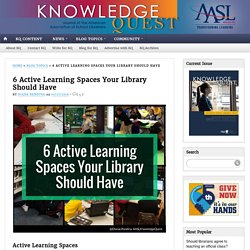
While this research (and this book) are not specifically focused on school libraries, we are the ideal place in our schools to encompass all six types of learning spaces in one location. We are the learning hubs of our schools after all. :) You might find that many of these spaces will overlap in your library, or that their purpose might shift depending on the day. That’s totally normal considering how flexible our spaces have to be. Aim for having all six areas available as much as possible. Small group areas In your library, make sure that you have areas available where small groups of students can meet, talk and brainstorm.
Large group areas By default, most school libraries already have a large group area. Community Area Technology rich area Makerspaces. DB FromLibtoLearningCommons VDiggs. KQ MarApr14 ClimbingtoExcellence. 21st-Century Libraries: The Learning Commons. Libraries have existed since approximately 2600 BCE as an archive of recorded knowledge.
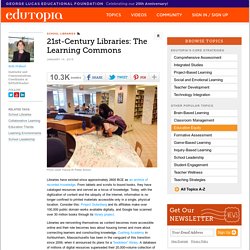
From tablets and scrolls to bound books, they have cataloged resources and served as a locus of knowledge. Today, with the digitization of content and the ubiquity of the internet, information is no longer confined to printed materials accessible only in a single, physical location. Consider this: Project Gutenberg and its affiliates make over 100,000 public domain works available digitally, and Google has scanned over 30 million books through its library project.
Libraries are reinventing themselves as content becomes more accessible online and their role becomes less about housing tomes and more about connecting learners and constructing knowledge. Cushing Academy in Ashburnham, Massachusetts has been in the vanguard of this transition since 2009, when it announced its plans for a "bookless" library. From Library to Learning Commons Photo credit: Francis W. 4 Tips to Transform Your Learning Space. Editor's Note: Elissa Malespina, Jennifer LaGarde, and Laura Flemming contributed to this post.
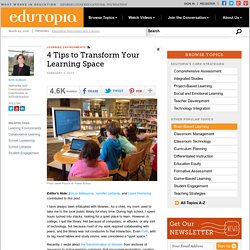
I have always been infatuated with libraries. As a child, my mom used to take me to the local public library for story time. During high school, I spent hours tucked into stacks, looking for a quiet place to learn. However, in college, I quit the library. Not because of computers, or eBooks, or any sort of technology, but because most of my work required collaborating with peers, and the library was not conducive to that interaction. Recently, I wrote about the transformation of libraries from archives of resources to active learning commons that encourage exploration, creation, and collaboration. Tip #1: Create an Agile Space Classrooms and libraries often have a uniform appearance even though they could be used for a multitude of activities. In a Teacher-Librarian Virtual Cafe webinar this fall, Jennifer co-presented the concept of MacGyver Librarianship: The Art of Doing More w/Less!
Year of the Learning Commons. Learning Commons: the Center of Participatory Learning and School Improvement Continuing their long service to children, teens and teacher, teacher librarians are developing new ways to not only support the consumption of knowledge through great collections in many formats but are encouraging everyone to create knowledge in the new world of information, technology, and the challenges of school improvement.
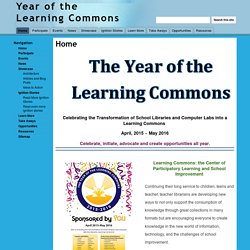
Major changes to traditional school libraries include the reinvention of physical space that meets the needs seeking a physical space that adapts to what they need at any given time. There is space for individuals, small groups and large groups who are using resources, making, building, creating, doing, and enjoying a very busy space that welcomes the use of many forms of technological devices. Digital resources and collaborative learning happens 24/7 in the Virtual Learning Commons Where learners can link to opportunities and work with others across the world. Learningcommons. UMass Amherst Libraries. The UMass Amherst Learning Commons is located on the Lower Level of the W.E.B.
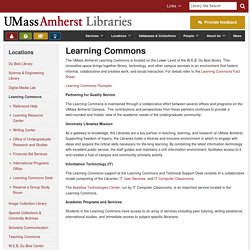
Du Bois library. This innovative space brings together library, technology, and other campus services in an environment that fosters informal, collaborative and creative work, and social interaction. For details refer to the Learning Commons Fact Sheet. Learning Commons Floorplan Partnering for Quality Service The Learning Commons is maintained through a collaborative effort between several offices and programs on the UMass Amherst Campus. University Libraries Mission. Librarian Design Share – inspiration for library creatives. ELI7071.